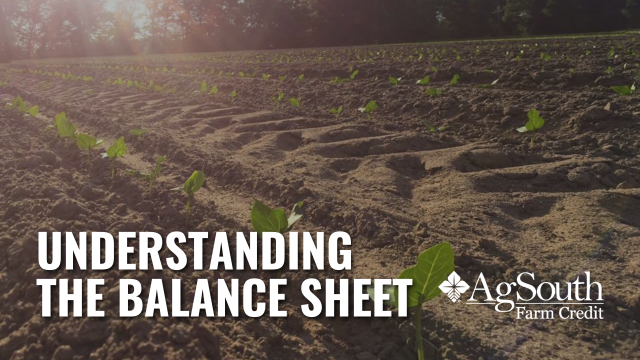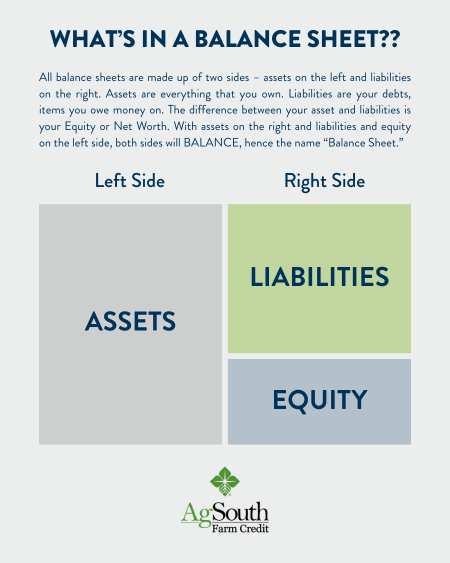Understanding the Balance Sheet: A Key Tool for Farm Financial Management

Understanding the Balance Sheet: A Key Tool for Farm Financial Management.
Managing a farm involves more than just planting crops and raising livestock. To ensure long-term success, it's crucial to understand the financial health of your operation. One of the most important tools for this is the balance sheet.
What is a Balance Sheet?
A balance sheet is a financial statement that provides a snapshot of your farm's financial position at a specific point in time. It outlines your assets, liabilities, and equity, helping you understand what you own, what you owe, and your net worth. It is the cornerstone of your farm’s finances and can help you as a farmer gauge from year to year how your operation is performing.
Components of a Balance Sheet
All balance sheets are made up of two sides – assets on the left and liabilities on the right. Assets are everything that you own. Liabilities are your debts, items you owe money on. The difference between your asset and liabilities is your Equity or Net Worth. With assets on the right and liabilities and equity on the left side, both sides will BALANCE, hence the name “Balance Sheet.”

Assets
- Current Assets: Items you own that will be used up or sold within one year. Examples include cash, feed, seed, fertilizer, crops in the ground, and feeder calves.
- Intermediate Assets: Items that support production and typically have a lifespan of 2-10 years. Examples include breeding livestock, vehicles, and equipment.
- Fixed/Long-Term Assets: Permanent items with a lifespan of more than 10 years. Examples include real estate, barns, and shelters.
Liabilities
- Current Debts: Debts that need to be paid within one year, such as operating loans, or open account financing such as credit accounts at farm supply centers.
- Intermediate Term Debts: Debts with a repayment period of 1-10 years, such as vehicle and equipment loans.
- Long Term Debts: Debts with a repayment period of more than 10 years, such as real estate mortgages.
Equity (Net Worth)
- Equity represents the value of the assets you actually own. Equity = Assets – Liabilities. This number reflects your farm's financial health and stability.
What Should the Balance Sheet Look Like?
Everyone’s balance sheet may look different based on the type and age of the operation. Farm operations just getting started will be heavy on the liabilities side and reflect a lower Equity, or Net Worth. That is normal! It takes time to build ownership of assets. More established operations will start to show more Assets, while Liabilities decrease over time, thus are higher in Equity. The higher your Equity, the stronger your operation is to weather difficult years.
Why is the Balance Sheet Important?
Financial Snapshot: Provides a clear picture of your farm's financial position at a specific point in time.
Loan Applications: Essential for lenders to assess your financial health when applying for loans.
Growth Tracking: Helps you as a producer gauge your farm's growth and financial position. Completing your balance sheet once a year around the same time (ex. January) will help you see trends in your farm’s financial position year over year.
Decision Making: Aids in making informed decisions about investments, expansions, and other financial matters related to your farm.
Creating a Balance Sheet
- List Your Assets (Everything you own): Categorize your assets into current, intermediate, and fixed/long-term assets. Include the value of each item. Include cash, feed, seed, fertilizer, feeder calves, breeding cattle, crops in the ground, vehicles, equipment, barns, shelters, and land.
- List Your Liabilities: Categorize your liabilities into current, intermediate term, and long term debts. Include operating lines, other lines of credit, equipment loans, leases, and land loans along with the amount owed for each debt.
- Calculate Equity: Subtract total liabilities from total assets (Assets-Liabilities) to determine your equity.
Watch: How to Complete a Balance Sheet
Download: Balance Sheet & Income Statement Spreadsheet
Tips for Maintaining an Accurate Balance Sheet
- Consistency: Prepare your balance sheet at the same time each year (ex. end of December or early January) to coincide with tax filings.
- Detail: Be thorough and accurate in listing all assets and liabilities. Do not try to hide assets or liabilities to make your balance sheet look a certain way. Be honest with yourself and your lender so you can make the best decisions for your farm.
- Review: Review your updated balance sheet with your lender or accountant that can partner with you to help you understand your farm’s financial position and make future decisions.
As CEO of your operation, understanding and maintaining a balance sheet is crucial for managing your farm's finances effectively. It provides valuable insights into your financial health, aids in loan applications, and helps track growth over time. By mastering the balance sheet, you can make informed decisions that contribute to the long-term success of your farming operation.